Human Resource Management: Functions, Strategies, and Impact
VerifiedAdded on 2020/05/11
|8
|2644
|82
Essay
AI Summary
This essay delves into the multifaceted functions of Human Resource Management (HRM) and its pivotal role in enhancing organizational efficiency and effectiveness. It explores how HRM contributes to achieving long-term goals through talent management, knowledge management, and performance management. The essay highlights the significance of recruitment, selection, training, and career development in attracting and retaining employees, emphasizing the importance of aligning these processes with organizational objectives. It also examines strategies for effective performance appraisals, addressing common issues such as inadequate feedback and lack of accountability. The analysis underscores the critical role of HRM in fostering a positive work environment, promoting employee engagement, and driving overall organizational success through various strategies. The paper emphasizes the importance of recruitment and selection, organizational training and development, and strategies to manage the issues associated with performance appraisal.
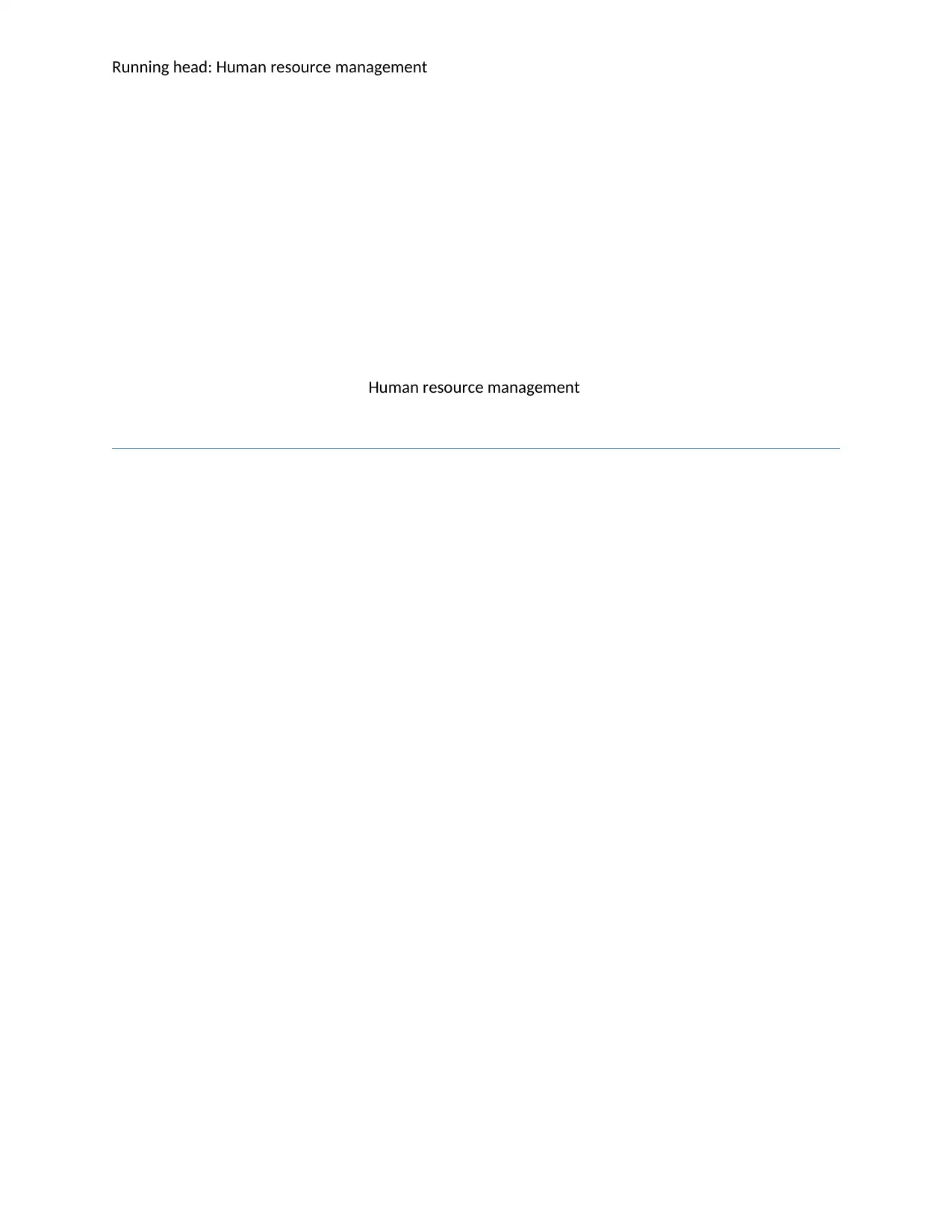
Running head: Human resource management
Human resource management
Human resource management
Paraphrase This Document
Need a fresh take? Get an instant paraphrase of this document with our AI Paraphraser
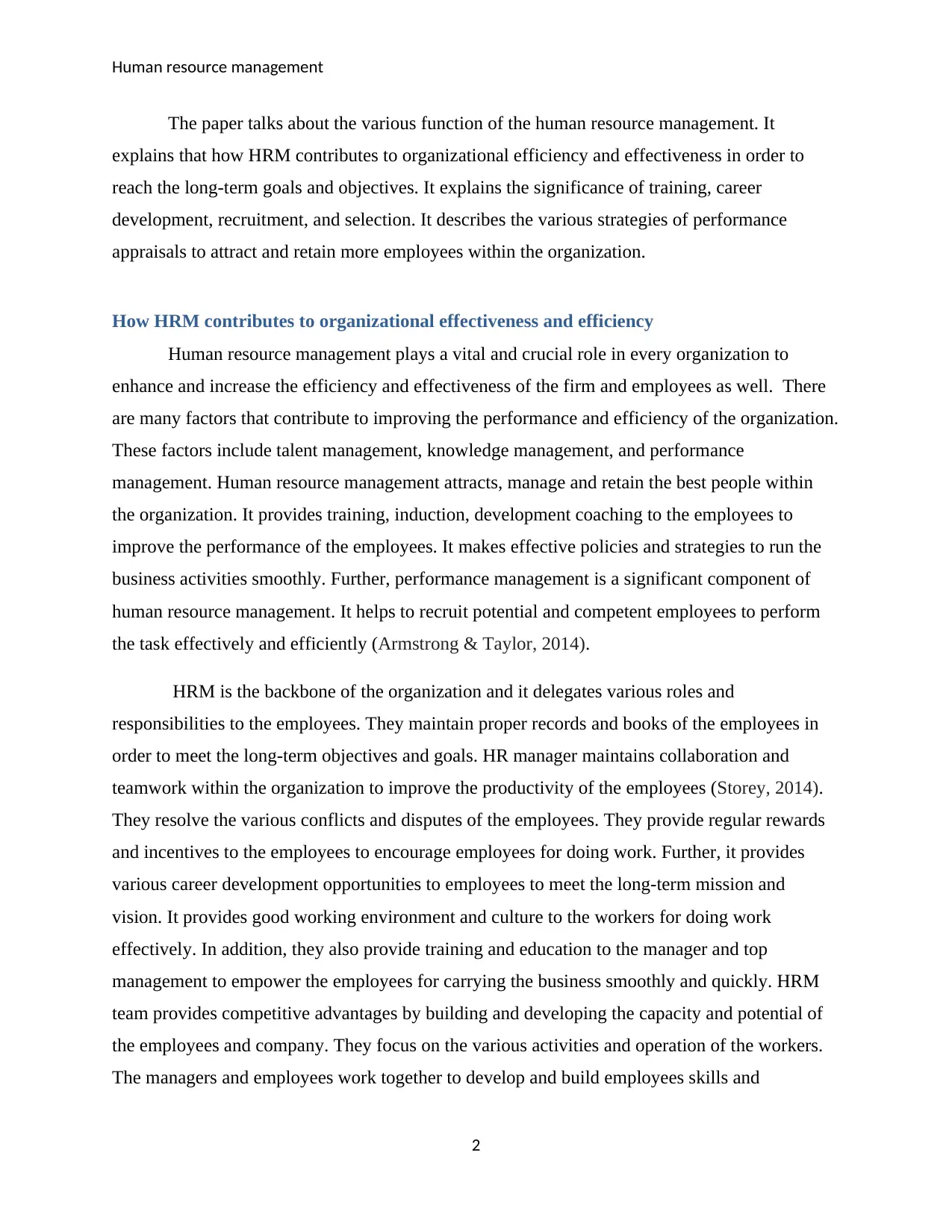
Human resource management
The paper talks about the various function of the human resource management. It
explains that how HRM contributes to organizational efficiency and effectiveness in order to
reach the long-term goals and objectives. It explains the significance of training, career
development, recruitment, and selection. It describes the various strategies of performance
appraisals to attract and retain more employees within the organization.
How HRM contributes to organizational effectiveness and efficiency
Human resource management plays a vital and crucial role in every organization to
enhance and increase the efficiency and effectiveness of the firm and employees as well. There
are many factors that contribute to improving the performance and efficiency of the organization.
These factors include talent management, knowledge management, and performance
management. Human resource management attracts, manage and retain the best people within
the organization. It provides training, induction, development coaching to the employees to
improve the performance of the employees. It makes effective policies and strategies to run the
business activities smoothly. Further, performance management is a significant component of
human resource management. It helps to recruit potential and competent employees to perform
the task effectively and efficiently (Armstrong & Taylor, 2014).
HRM is the backbone of the organization and it delegates various roles and
responsibilities to the employees. They maintain proper records and books of the employees in
order to meet the long-term objectives and goals. HR manager maintains collaboration and
teamwork within the organization to improve the productivity of the employees (Storey, 2014).
They resolve the various conflicts and disputes of the employees. They provide regular rewards
and incentives to the employees to encourage employees for doing work. Further, it provides
various career development opportunities to employees to meet the long-term mission and
vision. It provides good working environment and culture to the workers for doing work
effectively. In addition, they also provide training and education to the manager and top
management to empower the employees for carrying the business smoothly and quickly. HRM
team provides competitive advantages by building and developing the capacity and potential of
the employees and company. They focus on the various activities and operation of the workers.
The managers and employees work together to develop and build employees skills and
2
The paper talks about the various function of the human resource management. It
explains that how HRM contributes to organizational efficiency and effectiveness in order to
reach the long-term goals and objectives. It explains the significance of training, career
development, recruitment, and selection. It describes the various strategies of performance
appraisals to attract and retain more employees within the organization.
How HRM contributes to organizational effectiveness and efficiency
Human resource management plays a vital and crucial role in every organization to
enhance and increase the efficiency and effectiveness of the firm and employees as well. There
are many factors that contribute to improving the performance and efficiency of the organization.
These factors include talent management, knowledge management, and performance
management. Human resource management attracts, manage and retain the best people within
the organization. It provides training, induction, development coaching to the employees to
improve the performance of the employees. It makes effective policies and strategies to run the
business activities smoothly. Further, performance management is a significant component of
human resource management. It helps to recruit potential and competent employees to perform
the task effectively and efficiently (Armstrong & Taylor, 2014).
HRM is the backbone of the organization and it delegates various roles and
responsibilities to the employees. They maintain proper records and books of the employees in
order to meet the long-term objectives and goals. HR manager maintains collaboration and
teamwork within the organization to improve the productivity of the employees (Storey, 2014).
They resolve the various conflicts and disputes of the employees. They provide regular rewards
and incentives to the employees to encourage employees for doing work. Further, it provides
various career development opportunities to employees to meet the long-term mission and
vision. It provides good working environment and culture to the workers for doing work
effectively. In addition, they also provide training and education to the manager and top
management to empower the employees for carrying the business smoothly and quickly. HRM
team provides competitive advantages by building and developing the capacity and potential of
the employees and company. They focus on the various activities and operation of the workers.
The managers and employees work together to develop and build employees skills and
2
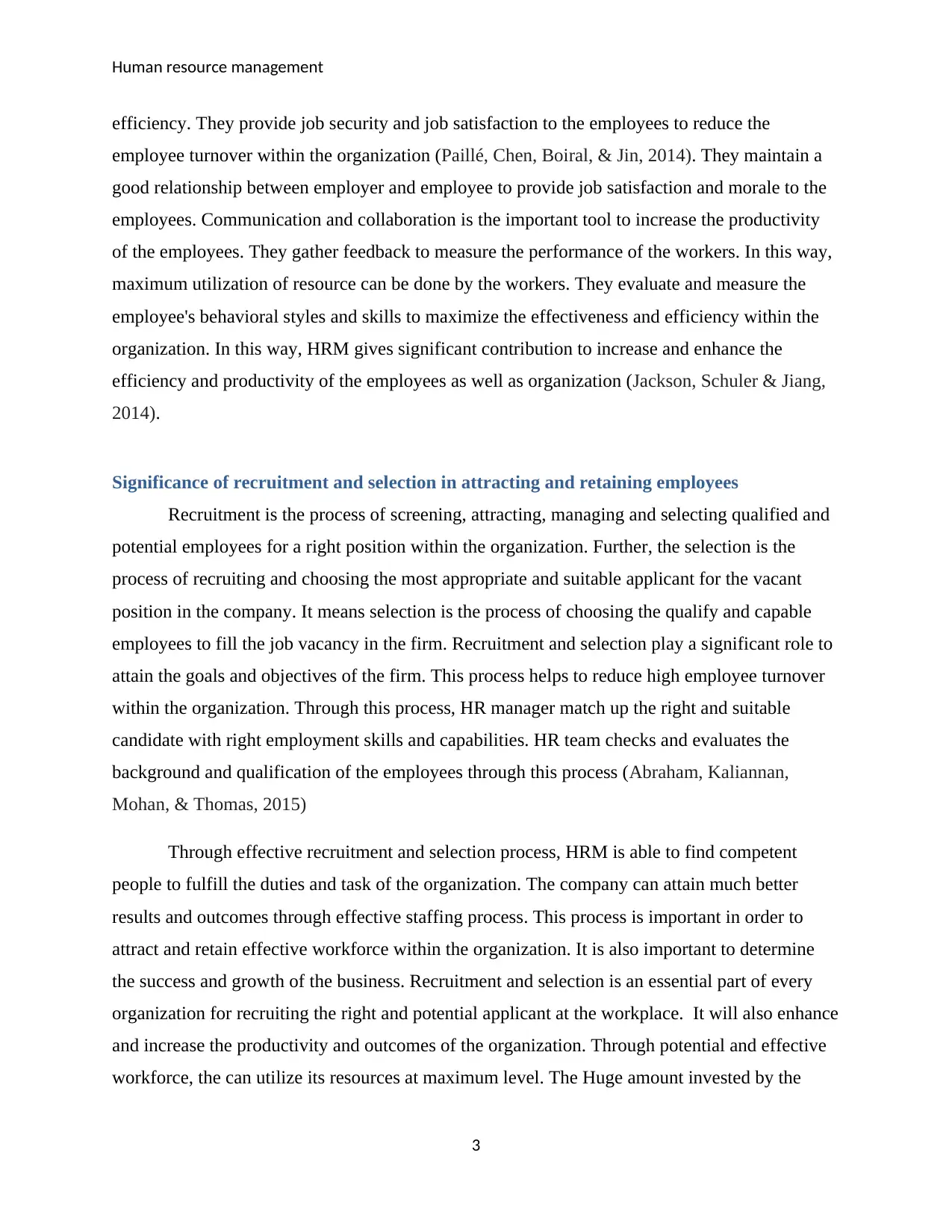
Human resource management
efficiency. They provide job security and job satisfaction to the employees to reduce the
employee turnover within the organization (Paillé, Chen, Boiral, & Jin, 2014). They maintain a
good relationship between employer and employee to provide job satisfaction and morale to the
employees. Communication and collaboration is the important tool to increase the productivity
of the employees. They gather feedback to measure the performance of the workers. In this way,
maximum utilization of resource can be done by the workers. They evaluate and measure the
employee's behavioral styles and skills to maximize the effectiveness and efficiency within the
organization. In this way, HRM gives significant contribution to increase and enhance the
efficiency and productivity of the employees as well as organization (Jackson, Schuler & Jiang,
2014).
Significance of recruitment and selection in attracting and retaining employees
Recruitment is the process of screening, attracting, managing and selecting qualified and
potential employees for a right position within the organization. Further, the selection is the
process of recruiting and choosing the most appropriate and suitable applicant for the vacant
position in the company. It means selection is the process of choosing the qualify and capable
employees to fill the job vacancy in the firm. Recruitment and selection play a significant role to
attain the goals and objectives of the firm. This process helps to reduce high employee turnover
within the organization. Through this process, HR manager match up the right and suitable
candidate with right employment skills and capabilities. HR team checks and evaluates the
background and qualification of the employees through this process (Abraham, Kaliannan,
Mohan, & Thomas, 2015)
Through effective recruitment and selection process, HRM is able to find competent
people to fulfill the duties and task of the organization. The company can attain much better
results and outcomes through effective staffing process. This process is important in order to
attract and retain effective workforce within the organization. It is also important to determine
the success and growth of the business. Recruitment and selection is an essential part of every
organization for recruiting the right and potential applicant at the workplace. It will also enhance
and increase the productivity and outcomes of the organization. Through potential and effective
workforce, the can utilize its resources at maximum level. The Huge amount invested by the
3
efficiency. They provide job security and job satisfaction to the employees to reduce the
employee turnover within the organization (Paillé, Chen, Boiral, & Jin, 2014). They maintain a
good relationship between employer and employee to provide job satisfaction and morale to the
employees. Communication and collaboration is the important tool to increase the productivity
of the employees. They gather feedback to measure the performance of the workers. In this way,
maximum utilization of resource can be done by the workers. They evaluate and measure the
employee's behavioral styles and skills to maximize the effectiveness and efficiency within the
organization. In this way, HRM gives significant contribution to increase and enhance the
efficiency and productivity of the employees as well as organization (Jackson, Schuler & Jiang,
2014).
Significance of recruitment and selection in attracting and retaining employees
Recruitment is the process of screening, attracting, managing and selecting qualified and
potential employees for a right position within the organization. Further, the selection is the
process of recruiting and choosing the most appropriate and suitable applicant for the vacant
position in the company. It means selection is the process of choosing the qualify and capable
employees to fill the job vacancy in the firm. Recruitment and selection play a significant role to
attain the goals and objectives of the firm. This process helps to reduce high employee turnover
within the organization. Through this process, HR manager match up the right and suitable
candidate with right employment skills and capabilities. HR team checks and evaluates the
background and qualification of the employees through this process (Abraham, Kaliannan,
Mohan, & Thomas, 2015)
Through effective recruitment and selection process, HRM is able to find competent
people to fulfill the duties and task of the organization. The company can attain much better
results and outcomes through effective staffing process. This process is important in order to
attract and retain effective workforce within the organization. It is also important to determine
the success and growth of the business. Recruitment and selection is an essential part of every
organization for recruiting the right and potential applicant at the workplace. It will also enhance
and increase the productivity and outcomes of the organization. Through potential and effective
workforce, the can utilize its resources at maximum level. The Huge amount invested by the
3
⊘ This is a preview!⊘
Do you want full access?
Subscribe today to unlock all pages.

Trusted by 1+ million students worldwide
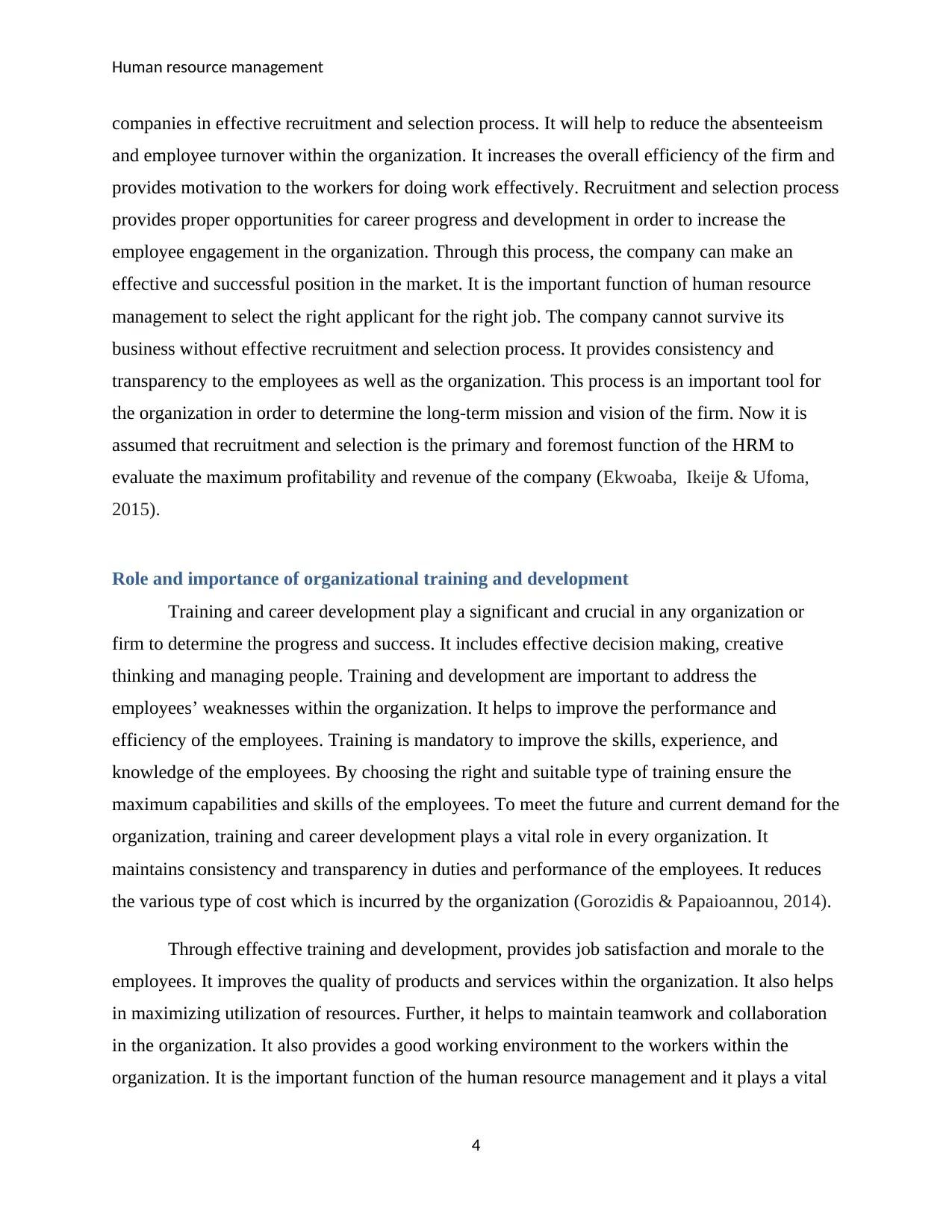
Human resource management
companies in effective recruitment and selection process. It will help to reduce the absenteeism
and employee turnover within the organization. It increases the overall efficiency of the firm and
provides motivation to the workers for doing work effectively. Recruitment and selection process
provides proper opportunities for career progress and development in order to increase the
employee engagement in the organization. Through this process, the company can make an
effective and successful position in the market. It is the important function of human resource
management to select the right applicant for the right job. The company cannot survive its
business without effective recruitment and selection process. It provides consistency and
transparency to the employees as well as the organization. This process is an important tool for
the organization in order to determine the long-term mission and vision of the firm. Now it is
assumed that recruitment and selection is the primary and foremost function of the HRM to
evaluate the maximum profitability and revenue of the company (Ekwoaba, Ikeije & Ufoma,
2015).
Role and importance of organizational training and development
Training and career development play a significant and crucial in any organization or
firm to determine the progress and success. It includes effective decision making, creative
thinking and managing people. Training and development are important to address the
employees’ weaknesses within the organization. It helps to improve the performance and
efficiency of the employees. Training is mandatory to improve the skills, experience, and
knowledge of the employees. By choosing the right and suitable type of training ensure the
maximum capabilities and skills of the employees. To meet the future and current demand for the
organization, training and career development plays a vital role in every organization. It
maintains consistency and transparency in duties and performance of the employees. It reduces
the various type of cost which is incurred by the organization (Gorozidis & Papaioannou, 2014).
Through effective training and development, provides job satisfaction and morale to the
employees. It improves the quality of products and services within the organization. It also helps
in maximizing utilization of resources. Further, it helps to maintain teamwork and collaboration
in the organization. It also provides a good working environment to the workers within the
organization. It is the important function of the human resource management and it plays a vital
4
companies in effective recruitment and selection process. It will help to reduce the absenteeism
and employee turnover within the organization. It increases the overall efficiency of the firm and
provides motivation to the workers for doing work effectively. Recruitment and selection process
provides proper opportunities for career progress and development in order to increase the
employee engagement in the organization. Through this process, the company can make an
effective and successful position in the market. It is the important function of human resource
management to select the right applicant for the right job. The company cannot survive its
business without effective recruitment and selection process. It provides consistency and
transparency to the employees as well as the organization. This process is an important tool for
the organization in order to determine the long-term mission and vision of the firm. Now it is
assumed that recruitment and selection is the primary and foremost function of the HRM to
evaluate the maximum profitability and revenue of the company (Ekwoaba, Ikeije & Ufoma,
2015).
Role and importance of organizational training and development
Training and career development play a significant and crucial in any organization or
firm to determine the progress and success. It includes effective decision making, creative
thinking and managing people. Training and development are important to address the
employees’ weaknesses within the organization. It helps to improve the performance and
efficiency of the employees. Training is mandatory to improve the skills, experience, and
knowledge of the employees. By choosing the right and suitable type of training ensure the
maximum capabilities and skills of the employees. To meet the future and current demand for the
organization, training and career development plays a vital role in every organization. It
maintains consistency and transparency in duties and performance of the employees. It reduces
the various type of cost which is incurred by the organization (Gorozidis & Papaioannou, 2014).
Through effective training and development, provides job satisfaction and morale to the
employees. It improves the quality of products and services within the organization. It also helps
in maximizing utilization of resources. Further, it helps to maintain teamwork and collaboration
in the organization. It also provides a good working environment to the workers within the
organization. It is the important function of the human resource management and it plays a vital
4
Paraphrase This Document
Need a fresh take? Get an instant paraphrase of this document with our AI Paraphraser
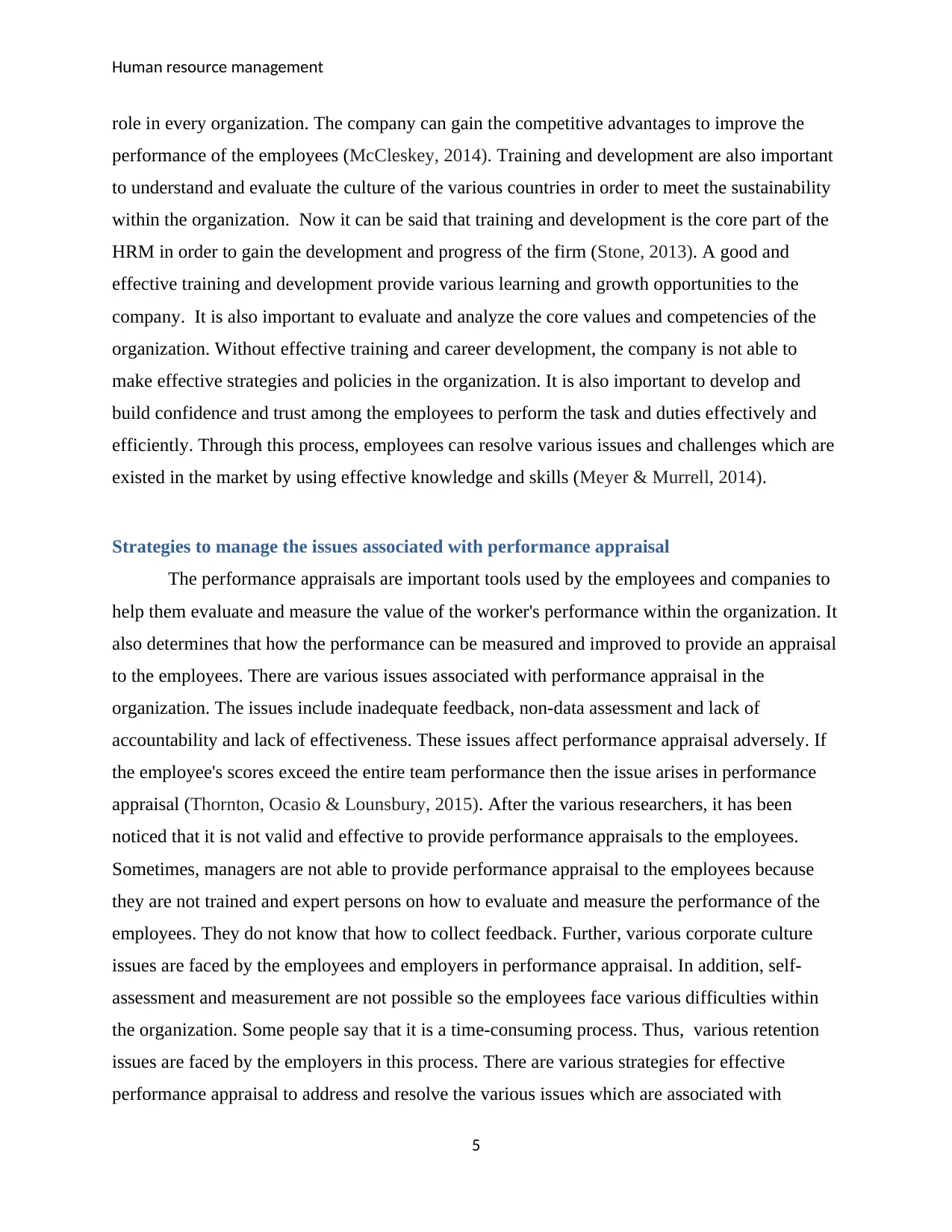
Human resource management
role in every organization. The company can gain the competitive advantages to improve the
performance of the employees (McCleskey, 2014). Training and development are also important
to understand and evaluate the culture of the various countries in order to meet the sustainability
within the organization. Now it can be said that training and development is the core part of the
HRM in order to gain the development and progress of the firm (Stone, 2013). A good and
effective training and development provide various learning and growth opportunities to the
company. It is also important to evaluate and analyze the core values and competencies of the
organization. Without effective training and career development, the company is not able to
make effective strategies and policies in the organization. It is also important to develop and
build confidence and trust among the employees to perform the task and duties effectively and
efficiently. Through this process, employees can resolve various issues and challenges which are
existed in the market by using effective knowledge and skills (Meyer & Murrell, 2014).
Strategies to manage the issues associated with performance appraisal
The performance appraisals are important tools used by the employees and companies to
help them evaluate and measure the value of the worker's performance within the organization. It
also determines that how the performance can be measured and improved to provide an appraisal
to the employees. There are various issues associated with performance appraisal in the
organization. The issues include inadequate feedback, non-data assessment and lack of
accountability and lack of effectiveness. These issues affect performance appraisal adversely. If
the employee's scores exceed the entire team performance then the issue arises in performance
appraisal (Thornton, Ocasio & Lounsbury, 2015). After the various researchers, it has been
noticed that it is not valid and effective to provide performance appraisals to the employees.
Sometimes, managers are not able to provide performance appraisal to the employees because
they are not trained and expert persons on how to evaluate and measure the performance of the
employees. They do not know that how to collect feedback. Further, various corporate culture
issues are faced by the employees and employers in performance appraisal. In addition, self-
assessment and measurement are not possible so the employees face various difficulties within
the organization. Some people say that it is a time-consuming process. Thus, various retention
issues are faced by the employers in this process. There are various strategies for effective
performance appraisal to address and resolve the various issues which are associated with
5
role in every organization. The company can gain the competitive advantages to improve the
performance of the employees (McCleskey, 2014). Training and development are also important
to understand and evaluate the culture of the various countries in order to meet the sustainability
within the organization. Now it can be said that training and development is the core part of the
HRM in order to gain the development and progress of the firm (Stone, 2013). A good and
effective training and development provide various learning and growth opportunities to the
company. It is also important to evaluate and analyze the core values and competencies of the
organization. Without effective training and career development, the company is not able to
make effective strategies and policies in the organization. It is also important to develop and
build confidence and trust among the employees to perform the task and duties effectively and
efficiently. Through this process, employees can resolve various issues and challenges which are
existed in the market by using effective knowledge and skills (Meyer & Murrell, 2014).
Strategies to manage the issues associated with performance appraisal
The performance appraisals are important tools used by the employees and companies to
help them evaluate and measure the value of the worker's performance within the organization. It
also determines that how the performance can be measured and improved to provide an appraisal
to the employees. There are various issues associated with performance appraisal in the
organization. The issues include inadequate feedback, non-data assessment and lack of
accountability and lack of effectiveness. These issues affect performance appraisal adversely. If
the employee's scores exceed the entire team performance then the issue arises in performance
appraisal (Thornton, Ocasio & Lounsbury, 2015). After the various researchers, it has been
noticed that it is not valid and effective to provide performance appraisals to the employees.
Sometimes, managers are not able to provide performance appraisal to the employees because
they are not trained and expert persons on how to evaluate and measure the performance of the
employees. They do not know that how to collect feedback. Further, various corporate culture
issues are faced by the employees and employers in performance appraisal. In addition, self-
assessment and measurement are not possible so the employees face various difficulties within
the organization. Some people say that it is a time-consuming process. Thus, various retention
issues are faced by the employers in this process. There are various strategies for effective
performance appraisal to address and resolve the various issues which are associated with
5
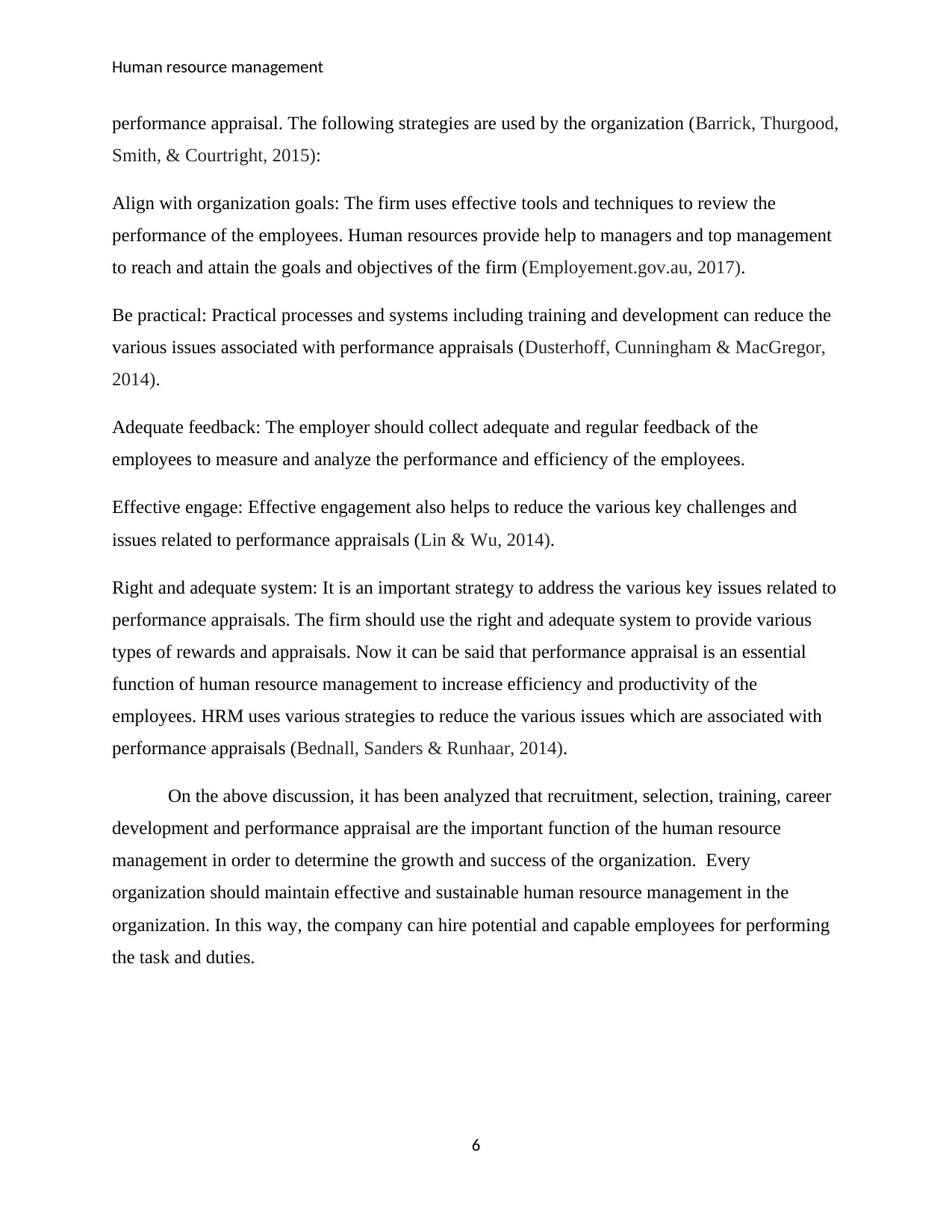
Human resource management
performance appraisal. The following strategies are used by the organization (Barrick, Thurgood,
Smith, & Courtright, 2015):
Align with organization goals: The firm uses effective tools and techniques to review the
performance of the employees. Human resources provide help to managers and top management
to reach and attain the goals and objectives of the firm (Employement.gov.au, 2017).
Be practical: Practical processes and systems including training and development can reduce the
various issues associated with performance appraisals (Dusterhoff, Cunningham & MacGregor,
2014).
Adequate feedback: The employer should collect adequate and regular feedback of the
employees to measure and analyze the performance and efficiency of the employees.
Effective engage: Effective engagement also helps to reduce the various key challenges and
issues related to performance appraisals (Lin & Wu, 2014).
Right and adequate system: It is an important strategy to address the various key issues related to
performance appraisals. The firm should use the right and adequate system to provide various
types of rewards and appraisals. Now it can be said that performance appraisal is an essential
function of human resource management to increase efficiency and productivity of the
employees. HRM uses various strategies to reduce the various issues which are associated with
performance appraisals (Bednall, Sanders & Runhaar, 2014).
On the above discussion, it has been analyzed that recruitment, selection, training, career
development and performance appraisal are the important function of the human resource
management in order to determine the growth and success of the organization. Every
organization should maintain effective and sustainable human resource management in the
organization. In this way, the company can hire potential and capable employees for performing
the task and duties.
6
performance appraisal. The following strategies are used by the organization (Barrick, Thurgood,
Smith, & Courtright, 2015):
Align with organization goals: The firm uses effective tools and techniques to review the
performance of the employees. Human resources provide help to managers and top management
to reach and attain the goals and objectives of the firm (Employement.gov.au, 2017).
Be practical: Practical processes and systems including training and development can reduce the
various issues associated with performance appraisals (Dusterhoff, Cunningham & MacGregor,
2014).
Adequate feedback: The employer should collect adequate and regular feedback of the
employees to measure and analyze the performance and efficiency of the employees.
Effective engage: Effective engagement also helps to reduce the various key challenges and
issues related to performance appraisals (Lin & Wu, 2014).
Right and adequate system: It is an important strategy to address the various key issues related to
performance appraisals. The firm should use the right and adequate system to provide various
types of rewards and appraisals. Now it can be said that performance appraisal is an essential
function of human resource management to increase efficiency and productivity of the
employees. HRM uses various strategies to reduce the various issues which are associated with
performance appraisals (Bednall, Sanders & Runhaar, 2014).
On the above discussion, it has been analyzed that recruitment, selection, training, career
development and performance appraisal are the important function of the human resource
management in order to determine the growth and success of the organization. Every
organization should maintain effective and sustainable human resource management in the
organization. In this way, the company can hire potential and capable employees for performing
the task and duties.
6
⊘ This is a preview!⊘
Do you want full access?
Subscribe today to unlock all pages.

Trusted by 1+ million students worldwide
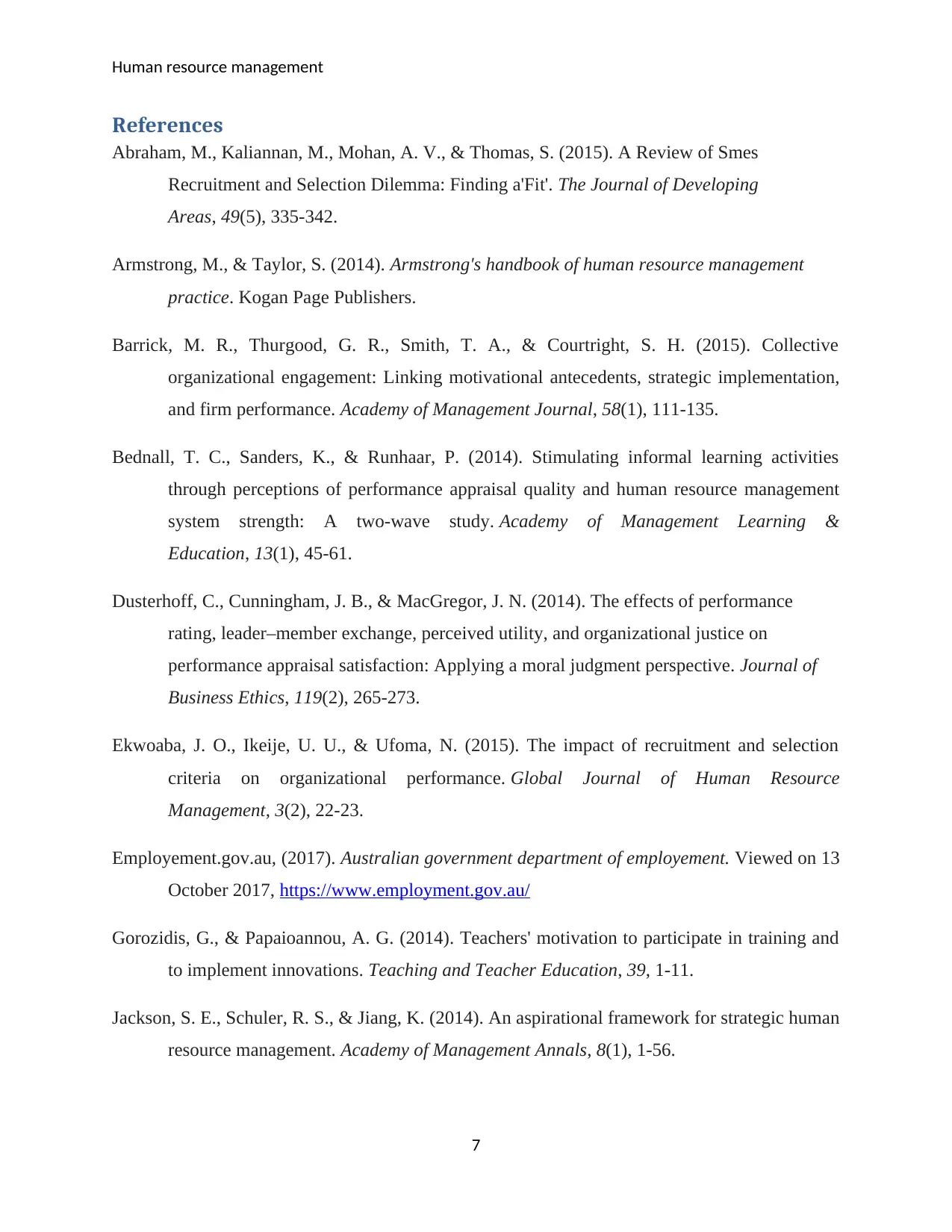
Human resource management
References
Abraham, M., Kaliannan, M., Mohan, A. V., & Thomas, S. (2015). A Review of Smes
Recruitment and Selection Dilemma: Finding a'Fit'. The Journal of Developing
Areas, 49(5), 335-342.
Armstrong, M., & Taylor, S. (2014). Armstrong's handbook of human resource management
practice. Kogan Page Publishers.
Barrick, M. R., Thurgood, G. R., Smith, T. A., & Courtright, S. H. (2015). Collective
organizational engagement: Linking motivational antecedents, strategic implementation,
and firm performance. Academy of Management Journal, 58(1), 111-135.
Bednall, T. C., Sanders, K., & Runhaar, P. (2014). Stimulating informal learning activities
through perceptions of performance appraisal quality and human resource management
system strength: A two-wave study. Academy of Management Learning &
Education, 13(1), 45-61.
Dusterhoff, C., Cunningham, J. B., & MacGregor, J. N. (2014). The effects of performance
rating, leader–member exchange, perceived utility, and organizational justice on
performance appraisal satisfaction: Applying a moral judgment perspective. Journal of
Business Ethics, 119(2), 265-273.
Ekwoaba, J. O., Ikeije, U. U., & Ufoma, N. (2015). The impact of recruitment and selection
criteria on organizational performance. Global Journal of Human Resource
Management, 3(2), 22-23.
Employement.gov.au, (2017). Australian government department of employement. Viewed on 13
October 2017, https://www.employment.gov.au/
Gorozidis, G., & Papaioannou, A. G. (2014). Teachers' motivation to participate in training and
to implement innovations. Teaching and Teacher Education, 39, 1-11.
Jackson, S. E., Schuler, R. S., & Jiang, K. (2014). An aspirational framework for strategic human
resource management. Academy of Management Annals, 8(1), 1-56.
7
References
Abraham, M., Kaliannan, M., Mohan, A. V., & Thomas, S. (2015). A Review of Smes
Recruitment and Selection Dilemma: Finding a'Fit'. The Journal of Developing
Areas, 49(5), 335-342.
Armstrong, M., & Taylor, S. (2014). Armstrong's handbook of human resource management
practice. Kogan Page Publishers.
Barrick, M. R., Thurgood, G. R., Smith, T. A., & Courtright, S. H. (2015). Collective
organizational engagement: Linking motivational antecedents, strategic implementation,
and firm performance. Academy of Management Journal, 58(1), 111-135.
Bednall, T. C., Sanders, K., & Runhaar, P. (2014). Stimulating informal learning activities
through perceptions of performance appraisal quality and human resource management
system strength: A two-wave study. Academy of Management Learning &
Education, 13(1), 45-61.
Dusterhoff, C., Cunningham, J. B., & MacGregor, J. N. (2014). The effects of performance
rating, leader–member exchange, perceived utility, and organizational justice on
performance appraisal satisfaction: Applying a moral judgment perspective. Journal of
Business Ethics, 119(2), 265-273.
Ekwoaba, J. O., Ikeije, U. U., & Ufoma, N. (2015). The impact of recruitment and selection
criteria on organizational performance. Global Journal of Human Resource
Management, 3(2), 22-23.
Employement.gov.au, (2017). Australian government department of employement. Viewed on 13
October 2017, https://www.employment.gov.au/
Gorozidis, G., & Papaioannou, A. G. (2014). Teachers' motivation to participate in training and
to implement innovations. Teaching and Teacher Education, 39, 1-11.
Jackson, S. E., Schuler, R. S., & Jiang, K. (2014). An aspirational framework for strategic human
resource management. Academy of Management Annals, 8(1), 1-56.
7
Paraphrase This Document
Need a fresh take? Get an instant paraphrase of this document with our AI Paraphraser
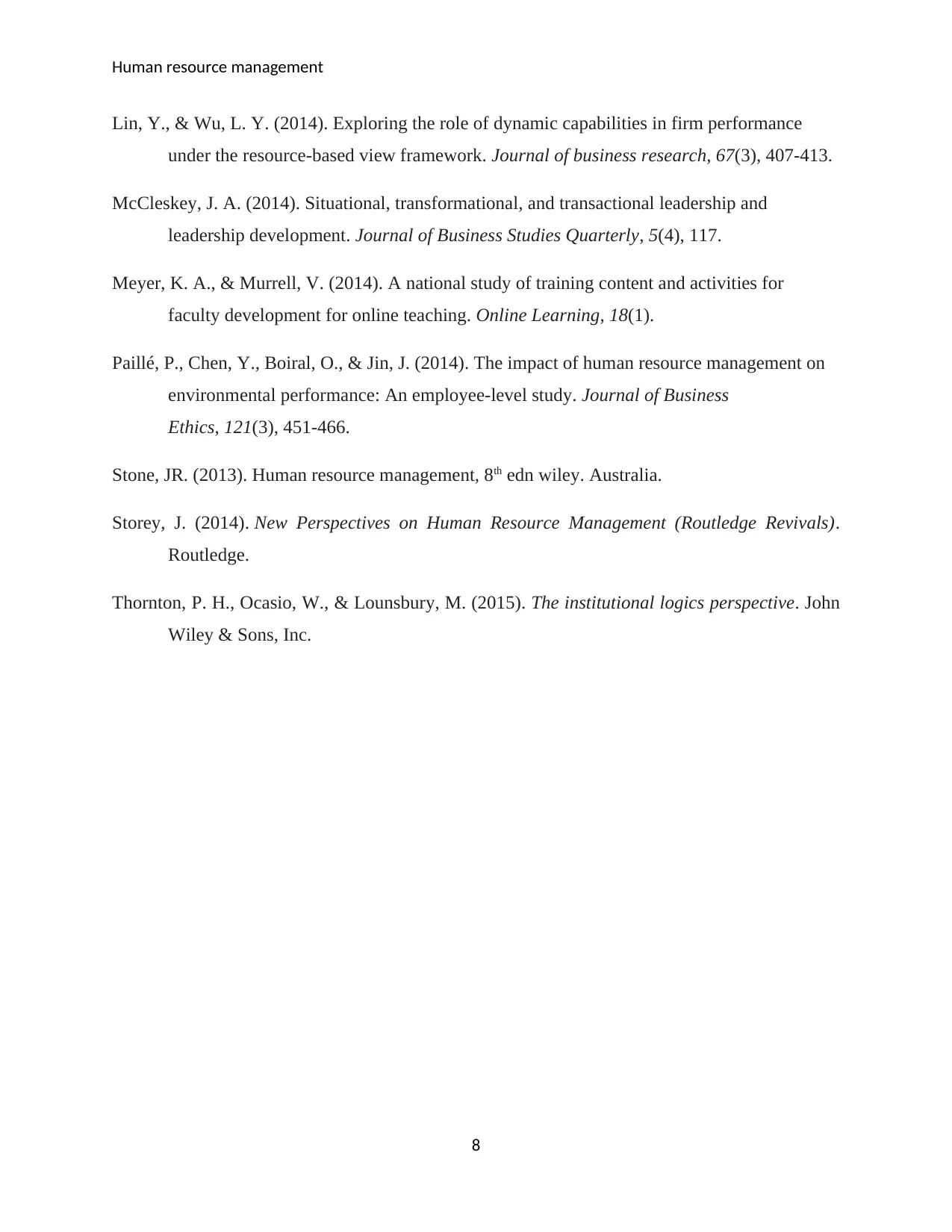
Human resource management
Lin, Y., & Wu, L. Y. (2014). Exploring the role of dynamic capabilities in firm performance
under the resource-based view framework. Journal of business research, 67(3), 407-413.
McCleskey, J. A. (2014). Situational, transformational, and transactional leadership and
leadership development. Journal of Business Studies Quarterly, 5(4), 117.
Meyer, K. A., & Murrell, V. (2014). A national study of training content and activities for
faculty development for online teaching. Online Learning, 18(1).
Paillé, P., Chen, Y., Boiral, O., & Jin, J. (2014). The impact of human resource management on
environmental performance: An employee-level study. Journal of Business
Ethics, 121(3), 451-466.
Stone, JR. (2013). Human resource management, 8th edn wiley. Australia.
Storey, J. (2014). New Perspectives on Human Resource Management (Routledge Revivals).
Routledge.
Thornton, P. H., Ocasio, W., & Lounsbury, M. (2015). The institutional logics perspective. John
Wiley & Sons, Inc.
8
Lin, Y., & Wu, L. Y. (2014). Exploring the role of dynamic capabilities in firm performance
under the resource-based view framework. Journal of business research, 67(3), 407-413.
McCleskey, J. A. (2014). Situational, transformational, and transactional leadership and
leadership development. Journal of Business Studies Quarterly, 5(4), 117.
Meyer, K. A., & Murrell, V. (2014). A national study of training content and activities for
faculty development for online teaching. Online Learning, 18(1).
Paillé, P., Chen, Y., Boiral, O., & Jin, J. (2014). The impact of human resource management on
environmental performance: An employee-level study. Journal of Business
Ethics, 121(3), 451-466.
Stone, JR. (2013). Human resource management, 8th edn wiley. Australia.
Storey, J. (2014). New Perspectives on Human Resource Management (Routledge Revivals).
Routledge.
Thornton, P. H., Ocasio, W., & Lounsbury, M. (2015). The institutional logics perspective. John
Wiley & Sons, Inc.
8
1 out of 8
Related Documents
Your All-in-One AI-Powered Toolkit for Academic Success.
+13062052269
info@desklib.com
Available 24*7 on WhatsApp / Email
![[object Object]](/_next/static/media/star-bottom.7253800d.svg)
Unlock your academic potential
Copyright © 2020–2025 A2Z Services. All Rights Reserved. Developed and managed by ZUCOL.





